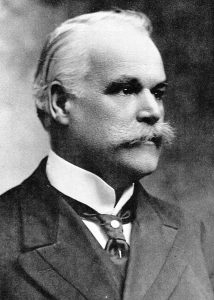1854-1920
Desjardins is the founder of the Quebec-based credit union now known as Mouvement Desjardins. It is the largest cooperative financial institution in Canada with over $260 billion in financial assets in 2015.
For 25 years (between 1892 and 1917), Desjardins worked as a French language stenographer for the House of Commons. As parliamentary sessions were shorter then, Desjardins never fully moved to Ottawa, keeping his family and permanent home in Lévis (Qc) and renting temporary accommodation for the four to six months a year when he was in the capital. During this time, Desjardins lived at at least six different Ottawa addresses, three of which (157 Nicholas St., 82 Daly Ave. and 192 Laurier Ave. E.) were in Sandy Hill.

Desjardins was interested in social reform and how mutual aid societies could be used to improve the condition of the working classes. In 1897, a private member’s bill introduced in the House of Commons to limit usurious rates of interest sparked his interest in the difficulties small borrowers had in accessing credit. Sceptical about the government’s ability to control usury, he looked for other solutions to the problem. In the Library of Parliament, he found a book by British author Henry Wolff (People’s Banks) that introduced him to the concept of cooperative banking. A meticulous, disciplined and methodical man, Desjardins spent three years researching various European models before founding the first savings and credit cooperative in the Americas in his home town. It is reported that Desjardins personally collected the savings of the cooperative’s members to start the business. At the end of the first day in January 1901, he had amassed a modest $26.40.
A tireless advocate for his cause, Desjardins gave hundreds of speeches, wrote countless articles and briefs and travelled extensively to promote cooperative banking. As a result, the cooperative movement grew quickly with new caisses populaires opening up in several Quebec and Ontario towns. Desjardins’ wife, Dorimène, played an important role in this early growth, managing the caisses’ affairs when her husband was in Ottawa.
For several years, Desjardins unsuccessfully lobbied the federal government to establish a legislative base for the caisses but the Senate eventually rejected a unanimous House bill by one vote on the grounds that the caisses fell under provincial jurisdiction. Starting in 1914, ill health forced Desjardins to start curtailing his activities. When he died in 1920, there were 140 caisses populaires in Quebec with several more in Ontario. Today, the Mouvement Desjardins has 335 caisses in Quebec and Ontario and over 47,000 employees.
